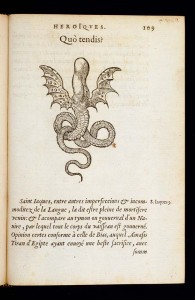‘Where are you going?’ The emblem addresses this question to an alarmingly disembodied tongue with whippy serpent’s tail and wings that strain to fly away. It expresses an anxiety that crops up constantly in Renaissance writing on the tongue and talk: that is, the ungovernable and uncontrollable nature of the tongue, and the fact that words cannot be taken back once spoken, but seem to take on a life of their own. The accompanying text refers to the tongue as an ambivalent organ, one that can be used for good or evil. But it’s the strange, almost uncanny autonomy of the tongue in the illustration that is most striking: uprooted from the mouth it flies off independently, a warning that this slippery organ needs careful governance and constant vigilance. There’s something interesting going on with the gendering of the tongue here too: while in the French text ‘la langue’ is insistently feminine, the illustration is undeniably phallic, with a muscular and virile energy. Where are you going? And, we might add, What are you, exactly?
Gossip and Nonsense
Excessive Language in Renaissance France


Hi! I spent weeks looking for the meaning of this beast by Paradin (I tried to translate the old French too …). Thanks you very much for the clear explanation. That’s helped me a lot. Thanks